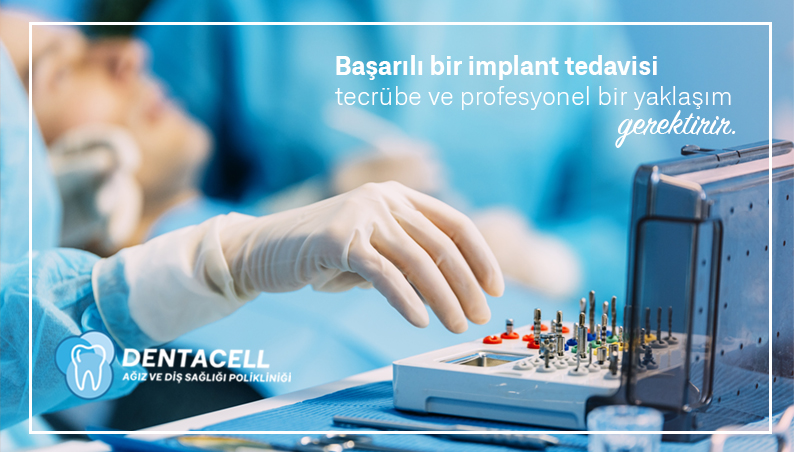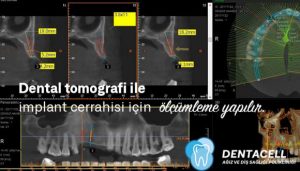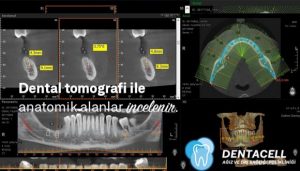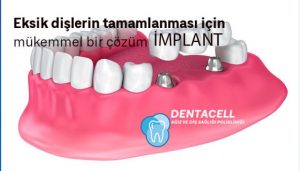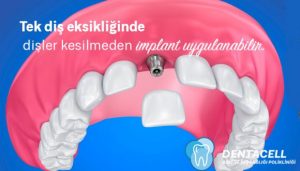Implantology
The purpose of all prosthetic treatments that need to be done due to tooth decay or loss is to imitate natural teeth as much as possible.
This goal becomes harder as the number of teeth in the mouth decreases.
Also, after a long time, changes in soft tissue and bone make it impossible to provide the function flawlessly.
The prosthesis becomes incompatible, it has lost its retention. In such cases, IMPLANT technology, a modern dental practice, can be used.
Implant Treatment Initial Procedures
Treatment planning mostly covers the pre-operative arrangement. Your dentist first checks all teeth and gums; treatments such as periodontal (gum) problems and bruises before starting implant-related procedures. If you have general health problems or use medication, a consultation with your doctor may be required.
Also, detailed anamnesis, panoramic x-ray, various tests (allergy, coagulation, etc.) must be requested before performing an implant operation.
If necessary, computed tomography is also required.
Implant Treatment Planning
Implants have three main indication groups: complete, partial and single tooth deficiencies. The number of implants to be applied is determined according to these three indications.
Single tooth deficiencies; It is an up-to-date treatment method in which the implant screw is inserted into the bone in the area of the dental cavity, the teeth in front and behind the missing teeth are not worn, and then a single crown is placed. It is successfully applied as an alternative to dental bridges. To apply a single dental implant, it is necessary to have enough space in that area and to have a bone suitable for the diameter and size of the implant screw.
Partial tooth deficiencies: Prosthetic (in terms of dental prostheses), it is recommended to treat partial edentulous cases with fixed dentures. For this, implantology helps prosthetic treatment. The implant itself is not a prosthesis, it is an element that supports the prosthesis. When the bridge restorations prepared with traditional methods in partial tooth deficiency are required to be cut, the teeth do not need to be cut and damaged in implant applications. Fixed crown coatings on dental implants are the types of prostheses that save patients from removable dentures that are attached and removed.
Total tooth deficiencies: In case of total tooth deficiency, fixed or removable prostheses can be applied depending on the patient’s bone condition and economic condition.
All-on-4
The all-on-4 implant system is the best solution for full jaw treatment using oblique implants.
The all-on-4 system is a low-cost and vaccine-free solution that provides patients with a fixed tamil prosthesis on the day of surgery.
Two flat implants are placed in front of the chin and two implants inclined up to 45 ° to the back of the chin. Complete arch rehabilitation is achieved with only four implants. Implants are placed in front of the mental nerves, especially when there is no space in the lower jaw. For patients who meet the criteria for immediate loading of implants, a temporary prosthesis is prepared immediately. Permanent prostheses are made following the Augmentation of the implants.
All on six
Only 6 implants are used to fix all teeth in the all on six implant system.
High-quality full-jaw tooth restorations can be done even if there is bone loss – in most cases, bone grafts are not required. Temporary dentures can be made immediately.

The All on 6 implant procedure ensures an effective restoration of the upper jaw especially because longer and stronger implants can be fixed to the back of the jaw.
Removable prosthesis applications: Depending on the sufficiency of the jaw bone, removable prostheses can be made using 2 or 4 implants. The connections of these prostheses to implants are provided by making ball attachments, locater or bar applications.


